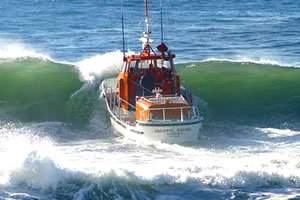





 Despite the continuing high cost of maintenance our six Waveneys (and the two somewhat younger 52ft Aruns) are the only purpose built, self-righting rescue lifeboats in any Australian volunteer rescue fleet.
Despite the continuing high cost of maintenance our six Waveneys (and the two somewhat younger 52ft Aruns) are the only purpose built, self-righting rescue lifeboats in any Australian volunteer rescue fleet. The Waveney class is a design of the US Coast Guard and there’s an enthusiast’s website at www.44mlb.com full of other info. The down side of these great boats is that they’re very costly to maintain as they’re all approaching 40 years of service. We’ve had almost 10 years from them but we know they will have to be replaced sooner rather than later, however funding suitable replacement vessels is a big mountain to climb. But we’ll get there.
The Waveney class is a design of the US Coast Guard and there’s an enthusiast’s website at www.44mlb.com full of other info. The down side of these great boats is that they’re very costly to maintain as they’re all approaching 40 years of service. We’ve had almost 10 years from them but we know they will have to be replaced sooner rather than later, however funding suitable replacement vessels is a big mountain to climb. But we’ll get there. The Royal Volunteer Coastal Patrol reminds all skippers that they are responsible for the safety of all their passengers and the time to check your boat is now – before you launch or leave your mooring on the weekend.
The Royal Volunteer Coastal Patrol reminds all skippers that they are responsible for the safety of all their passengers and the time to check your boat is now – before you launch or leave your mooring on the weekend. There is a checklist of 24 items in the NSW Maritime Boating Handbook. This is available from your local volunteer marine rescue organisation, NSW Maritime offices. Get a copy and be a Smart Skipper because the more thorough your boating safety check, the less likelihood you’ll need to call for help.
There is a checklist of 24 items in the NSW Maritime Boating Handbook. This is available from your local volunteer marine rescue organisation, NSW Maritime offices. Get a copy and be a Smart Skipper because the more thorough your boating safety check, the less likelihood you’ll need to call for help.